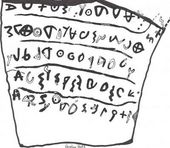
© University of HaifaThe ancient text shown in this drawing was discovered on a shard of pottery in Israel, and turned out to be the earliest known example of Hebrew writing.
Scientists have discovered the earliest known Hebrew writing - an inscription dating from the 10th century B.C., during the period of King David's reign.
The breakthrough could mean that portions of the Bible were written centuries earlier than previously thought. (The Bible's Old Testament is thought to have been first written down in an ancient form of Hebrew.)
Until now, many scholars have held that the Hebrew Bible originated in the 6th century B.C., because Hebrew writing was thought to stretch back no further. But the newly deciphered Hebrew text is about four centuries older, scientists announced this month.
"It indicates that the Kingdom of Israel already existed in the 10th century BCE and that at least some of the biblical texts were written hundreds of years before the dates presented in current research," said Gershon Galil, a professor of Biblical Studies at the University of Haifa in Israel, who deciphered the ancient text.
BCE stands for "before common era," and is equivalent to B.C., or before Christ.
The writing was discovered more than a year ago on a pottery shard dug up during excavations at Khirbet Qeiyafa, near Israel's Elah valley. The excavations were carried out by archaeologist Yosef Garfinkel of the Hebrew University of Jerusalem. At first, scientists could not tell if the writing was Hebrew or some other local language.




Comment: Interesting bunch running iDefense: